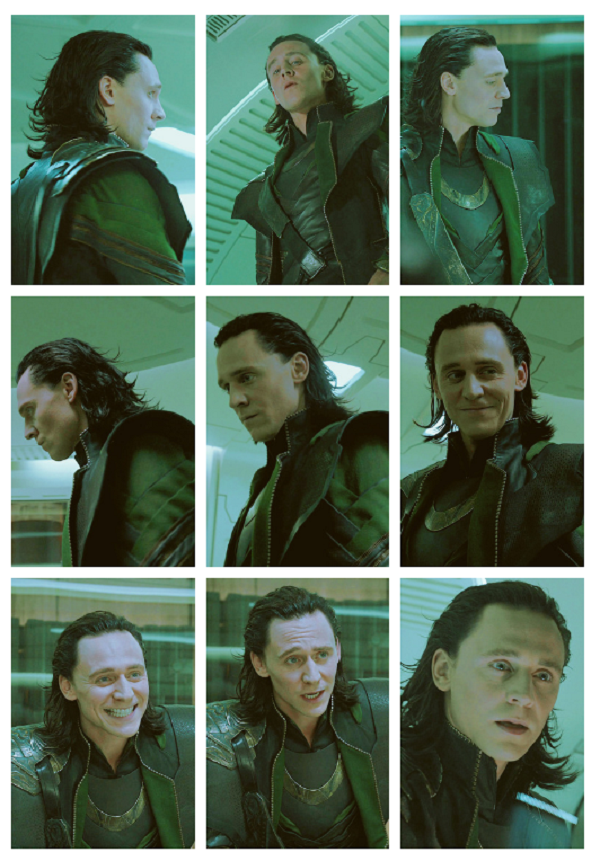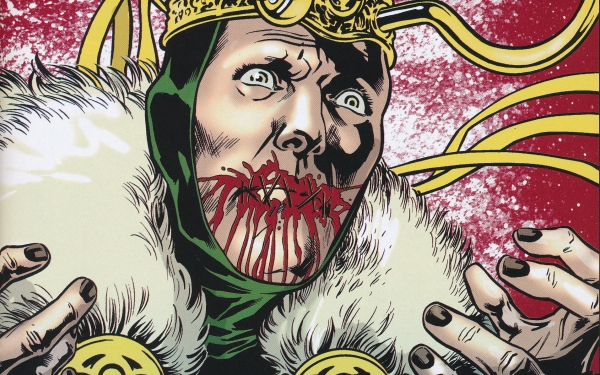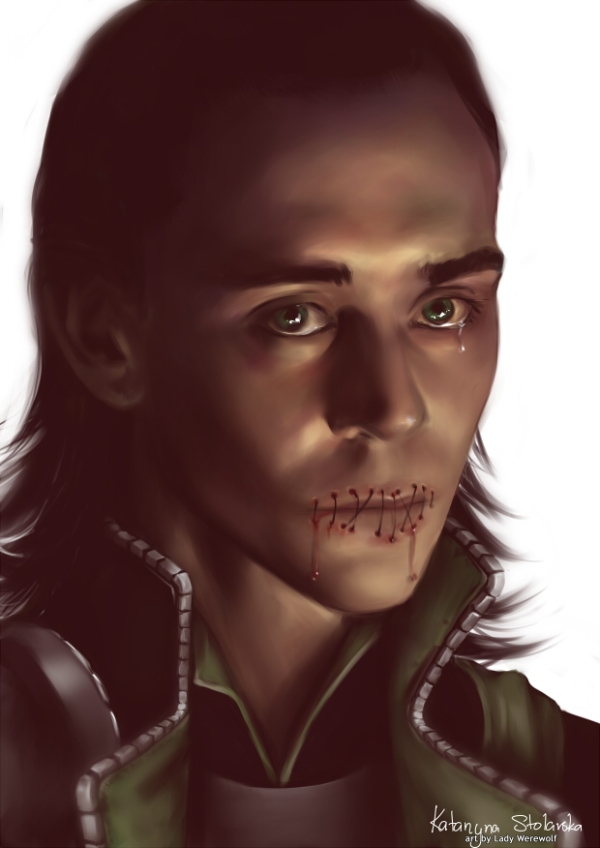[0.3] O most pernicious woman!!
O villain, villain, smiling, damned villain!
My tables—meet it is I set it down!
That one may smile, and smile, and be a villain—!
At least I am sure it may be so in Denmark.—Hamlet 1.5.105–109
1. Introduction
[1.1] As it is in Denmark, so may it be in fandom. Marvel's Loki has gathered quite a following in his journey from comic to film in Thor (dir. Kenneth Branagh, 2011) and The Avengers (dir. Joss Whedon, 2012). But how does one love a villain? It's indeed the how, and not the why, that's key. Where one might expect to find lengthy textual analyses rationalizing an attraction to Loki, the microblogging platform Tumblr brims with image posts, many without substantial text to contextualize or expand upon the visual (figure 1).
[1.2] Has Loki fandom fallen prey to the trickster's physical manifestation? Concluding a post about how one can "like and empathize with a villain and still disapprove of his actions," majesticgingerbear (2012) reflects. "Or, maybe, we're all just suckers for a pretty face." This demonstrates awareness of the implications of being a fan of a character portrayed by a handsome actor like Tom Hiddleston. Visual appreciation doesn't delimit overall character comprehension, yet some have used it to suggest that, as one Tumblr post asserts, Loki fans' "cognitive skills…are being hindered by Tom's beauty" and that "maybe they should just walk away from this engrossing franchise" (note 1).

Figure 1. A photo set posted on Tumblr by angelfish69. [View larger image.]
[1.3] Many Loki fans exhibit critical consciousness of their precarious position. angelfish69's photo set situates her gaze within an intertextual framework by including the quotation "O villain, villain, smiling, damned villain!" Further, she expresses desire for Loki in her addendum, "Although he can smile at me anytime" (2012). The "although" registers her awareness of that disjuncture—Loki is the god of lies, a villain wrapped in a smile. Are the Loki fangirls, then, those most pernicious women, duped by the visual presentation? Is the elevation of Loki's character to a Shakespearean complexity undercut by attention to the image?
[1.4] I posit that Loki fandom actively negotiates this potential conflict between character as Text (interpretations of Loki by those with textual authority, such as film writers, directors, and actors, and comic artists and authors) and as primarily image (in the form of visual representations repeated across Tumblr). Although we function in a culture saturated with the visual, in what W. J. T. Mitchell calls "an age of 'spectacle' (Guy Debord), 'surveillance' (Foucault), and all-pervasive image-making," Mitchell also maintains that "we still do not know what exactly pictures are, what their relation to language is, how they operate on observers and the world…and what is to be done with or about them" (1995, 13). This anxiety surrounding the ubiquity of the image affects our discourse about the visual, and in considering fan activity on Tumblr, I believe that it's critical that we examine the visual as discourse.
2. Loki fandom as Tumblr case study
[2.1] Loki fandom on Tumblr, with its pervasive image making, serves as a particularly potent case study as the fans work to enter into an already complex discourse community. Hiddleston's Loki is a filmic character that may be (or alternatively may not be) approached from multiple knowledge bases. His latest appearance, in The Avengers, can be placed in dialogue with Thor, numerous comics of different runs and universes, animated series, Norse mythology, and the additional paratext of Hiddleston's own interpretation of the character. There is, then, a plethora of material from which to construct a view of Loki that allots him depth, motivations, sympathy, empathy, and even redemption, whether as developed in fan works or anticipated in future films.
[2.2] The resistance to such expression seems to stem in part from a belief that many Loki fans on Tumblr are emotionally or superficially invested in the filmic Loki as opposed to being intellectually invested in any of the other properties, and from a suspicion of the image of Hiddleston as Loki—and of Tumblr's repetition of it. This critique of the (primarily) female gaze in a medium already largely dependent upon visual representation is problematic. Further, the idea that Loki fans misunderstand the concept of the villain, and thus fundamentally misunderstand Loki, divides fannish expression into an intellectual and purist hierarchy. It's important to note that movieverse Loki fans are not the only ones to see Loki as inviting empathy or sympathy. If Loki was once of the mustache-twirling villain variety, recent comics Loki and Thor: Blood Brothers (2010) and Thor: The Trials of Loki (2011) endeavor to offer the trickster the chance to tell his story.
[2.3] Visual posts on Tumblr can break down these hierarchies by exhibiting engagement with multiple sources and providing coherent meaning for other viewers, even when those viewers might not immediately understand the intertextual nature of the posts. Photos, GIFs, and art that appropriate the filmic Loki's image work to negotiate the tension between privileged Loki texts (official comics and film) and the image posts, which are suspected of having no significant verbal meaning. I propose that emotional and intellectual expression is subtly converging in Loki fandom's employment of the image as text, specifically as intertextual imagetexts.
3. Theoretical framework
[3.1] In referring to the text, I adopt Roland Barthes's idea of the work versus the text: the work is what we consume (the films and comics), and the text is what happens when we "decant" the text from the work and "recuperate" it as "play, task, production, practice" (1977, 161–62). Barthes maintains that the text "exists only when caught up in a discourse" (157). Many would agree that a fan drawing constitutes play and production, but does it follow that screencaps and GIFs actively engage with the work from which they derive? Or are they copies, and further, simply copies upon copies, as they and more traditional forms of fan art are reblogged? Or can they be considered part of a discourse?
[3.2] Images have a language, and in evaluating the discourse that visuals on Tumblr engage in, Mitchell's (1995) notion of imagetext provides a useful concept. In the simplest sense, imagetexts are works that combine image and text or other verbal expression: a picture with a caption, a comic, or a film. But images without text can also be considered imagetexts, because "in the act of interpreting or describing pictures, even in the fundamental process of recognizing what they represent, language enters into the visual field" (52). Whether or not I talk about an image post on Tumblr, and whether or not it even contains words, in order to make sense of the image, I enfold it into my own mental discourse, drawing upon memories and knowledge that might contextualize or interpret it for me.
[3.3] Barthes also offers tools to examine the function of the imagetext in his definitions of anchorage (text that supports the image), illustration (image that supports the text), and relay (image and text that work in tandem) (1977, 38). I position fan-created images on Tumblr as engaging primarily in anchorage or relay, depending upon the knowledge base with which the viewer approaches them. Here Julia Kristeva's concept of intertextuality proves pertinent. Kristeva (1980) positions any text along two axes: one that connects the creator and audience of a work, and one that connects the work to other works. Where these two axes converge is where intertextuality most strongly occurs. Many of the imagetexts function differently for each viewer, according to the viewer's ability to experience those moments of convergence; Tumblr offers a space where intertextuality develops wider coherency through its pervasive dispersion.
4. Intertextual imagetexts

Figure 2. An example of a reaction GIF, by lokism. [View larger image.]
[4.1] Reaction GIFs are popular in many fandoms; although the GIF in figure 2 was created by lokism, other Tumblr users embed it into their own posts freely. The GIF could express meaning without the text if a viewer aligned the visual with familiar emotional cues: the flailing arms could indicate excitement or even panic. With the text "fangirling" added, the image comes to function more specifically, symbolizing fan emotion or behavior. It could be employed to indicate an excitement about any fandom-related scenario, or specifically for a post relating to The Avengers, Loki, or Hiddleston. A Tumblr user could decide to employ the GIF because it represents the feeling she's trying to express, or she might choose it over other GIFs because of her knowledge of its origin: an interview with Hiddleston in which he discusses Loki with fanlike enthusiasm. In this context, the use of the "fangirling" GIF in Loki fandom creates a connection to Hiddleston and positions him as an authoritative figure in interpreting Loki.
[4.2] When lokism inserts text into her GIF, she anchors the visual with verbal meaning. Most image captions, as in newspapers, translate or mimic the image, offering textual certainty of its context. A documentary voice-over might serve a similar function, though it can provide a tone or argument that demands the images be read through a particular ideological lens. Both assert the power of the verbal over the image. The imagetext GIF at once functions within this system and within Barthes's "relay" mode, in which "text…and image stand in a complementary relationship; the words, in the same ways as the images, are fragments of a more general syntagm and the unity of the message is realized at a higher level" (1977, 41). In a GIF with text, the question of whether image or text is to be privileged invites a critical gaze. If the use of lokism's GIF creates a feeling of connection with and validation by Hiddleston, it's ultimately the fan who controls the meaning of the imagetext in how she employs it, putting the visual into play in an ongoing discourse.

Figure 3. Loki with his lips sewn shut, from Thor: The Trials of Loki. [View larger image.]

Figure 4. "Loki: Mouth Shut" by Lady Werewolf. [View larger image.]
[4.3] Fan art adapting images from the comics to incorporate the movieverse's visualization of Loki is also posted regularly on Tumblr, and revisions of a scene from Thor: The Trials of Loki (adapted from Norse myth) in which Loki's mouth is sewn shut are particularly prevalent. What does refiguring the scene with Hiddleston's likeness accomplish? Rather than being only repetition with superficial variation, such a refiguring further challenges the notion that the Loki fan is susceptible to the lure of the empty visual text.
[4.4] Thor: The Trials of Loki explores how Loki nearly begins Ragnarok through a series of events drawn from myth, but in this version of the story, Loki is allowed to contextualize his misdeeds in his own narrative. Loki lies to the dwarves Brokk and Eitri in order to trick them into creating a collection of treasures for him, which he intends to give to the other gods so that they will love him. When his trickery is discovered, however, Brokk appeals to Thor for recompense, and Thor helps to hold Loki down while the dwarf sews his lips shut to prevent him from telling more lies. When Loki recounts this story, Thor says that he doesn't remember doing so, and a distraught Loki insists, "But you did! You helped, and you laughed…I heard the laughter as I pulled the thread from my mouth and thought: 'I do not belong…I am alone'" (Aguirre-Sacasa and Fiumara 2011, 25–26). The brothers continue to challenge each other's memories, and whatever the truth, Loki sees the incident as particularly formative. It defines him, and he narrates it in a fashion that invites sympathy.
[4.5] By adapting the scene from the comic (figure 3) in her own art (figure 4), Lady Werewolf places the movieverse Loki in dialogue with the Loki of myth and comics canon. Whereas Aguirre-Sacasa and Fiumara are able through multiple panels to show the painful process that Loki undergoes, as well as Thor's questioning of the narrative's truth, Lady Werewolf's image can only speak to one moment, with no assurance that her viewer has other textual knowledge. In presenting Loki alone, with no context to indicate who has sewn his lips shut or why, she draws attention to his still features and single tear, inviting the viewer to linger on his sadness and potentially create a narrative to explain what has brought him to this condition and what it means to the viewer to observe him.
[4.6] The initial experience of Lady Werewolf's art depends in part upon the viewer's knowledge base; reblogs of her post indicate varying levels of familiarity with the original mythology, the comic itself, and other fan art adaptations. The pervasiveness of the image across Tumblr, with each reblog potentially providing new context and a new interpretation of what the image accomplishes, creates an intertextual discourse for Loki fans regardless of their knowledge base, however. Other adaptations of this scene position Thor as the one who either sews or pulls out the thread, painting Loki as victim and opening the image of his suffering up to the viewer as a way to, through empathy or sympathy, actively engage with the text.
5. Conclusion
[5.1] Tumblr is rife with other examples of intertextuality and command of imagery in Loki fandom. But does the application of images of Hiddleston as Loki serve as a suitable language for a discourse about whether Loki is a villain or deserving of the emotional investment fans have in him? To express emotional investment requires a language with which to speak about it, and the continual employment of these images across Tumblr, a platform for communication, should invite serious consideration. Barthes posits that once the text is engaged as activity, "it follows that the Text cannot stop…the constitutive movement of the Text is a traversal" (1977, 157). The mobility of the image on Tumblr and the mobility of Barthes's text both suggest to me Barthes's space of a "transparency of language relations…the space in which no language prevails over any other, where the languages circulate" (1977, 164). As fans increasingly migrate to Tumblr from sites like LiveJournal, understanding the language of its denizens is crucial for engaging with any fannish discourse.